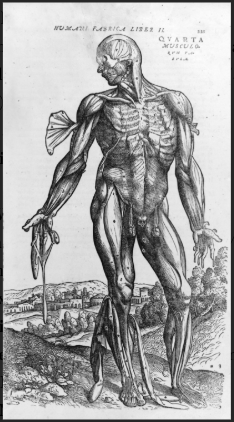“Touch comes before sight, before speech. It is the first language, and the last, and it always tells the truth.”

DaVinci dissected 30 human bodies in his lifetime. He wrote: “Man has been called by the ancients a lesser world, and indeed the name is well applied; because, as man is composed of earth, water, air, and fire…this body of the earth is similar.” He compared the human skeleton to rocks (“supports of the earth”) and the expansion of the lungs in breathing to the ebb and flow of the oceans.

Andreas Vesalius was a 16th-century Flemish anatomist, physician, and author of one of the most influential books on human anatomy, De humani corporis fabrica (On the Fabric of the Human Body). Vesalius is often referred to as the founder of modern human anatomy. He was born in Brussels, which was then part of the Habsburg Netherlands.
THE ARTIST: John of Calcar (John Stephen Calcar) (Netherlandish, Calcar, Cleves 1499–1546/50 Naples (active Italy)
Parts of this publication are on view at the Metropolitan Museum of Art.

image credit @storia.dellarte
It is likely an image of Minnehaha, from Longfellow’s poem, Song of Hiawatha




One of my favorite anatomical artists is Frank H. Netter (1906-1991) who published An Atlas of Human Anatomy just years before his death.




From the Book: De humani corporis fabrica libri septem / Andreae Vesalii. (Basel, 1555) Galter Health Sciences Library, Special Collections, Northwestern University, Chicago.

J.G. Ballard wrote the book “Crash,” which was made into that 1996 psycho-erotic-thriller about car crash victims. Remember that? It was pretty out there.




Male anatomical figure showing back muscles














